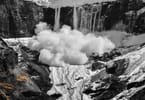The wait is almost over when on Saturday, April 30, some 105 tons of ivory will be destroyed in a setting at Nairobi National Park. This was inspired by relentless campaigners like Dr. Paula Kahumbu, whose “Hands off our Elephants” had raised global attention to the plight of the African elephant.
Previously, former President Daniel arap Moi set ivory alight on July 19, 1989, notably a whole year before a global ivory trade ban came into effect. Former President Mwai Kibaki then did the same during a ceremony in Tsavo National Park on July 20, 2011 as did current President Uhuru Kenyatta on March 3 of last year, at which time he promised to put the country’s entire ivory stock beyond economic use.
Kenya’s unprecedented step sets the country apart from many other elephant range countries where the governments are still hanging on to the notion that their stocks may eventually be sold, forgetting that it was the loosening of sales regulations by CITES in the first place which saw the blood ivory trade and poaching reach industrial levels and which, in neighboring Tanzania, wiped out tens of thousands of elephant over the last several years of the regime of former President, Jakaya Kikwete. While that administration stood by almost idle in the face of the onslaught, they lobbied hard to sell ivory on the world market, a notion which after the Nairobi burn on Saturday will be put firmly to rest.
African governments will find themselves under increased scrutiny and pressure now that Kenya is putting over 105 tons of ivory beyond use, to follow suit and either burn it or crush it.
The presence of Chinese officials on Saturday will be greeted by many with incredulity, as that country is seen as the main global driver for blood ivory and most customs seizures have taken place en route or on arrival in China. Sadly, more than 90 percent of all arrests made by airport security in Nairobi for illegal ivory trafficking are of Chinese origin, so officials present on Saturday ought to take a stark message back home to Beijing to finally ban all trade, craft, and possession of ivory, to pull the rug from underneath the demand side.
While poaching in Kenya is thankfully well contained, in spite of periodic reports of dead elephant being found, mostly courtesy of a renewed effort to fight poaching since Dr. Richard Leakey was appointed to chair the organization’s Board of Trustees, poaching of elephant for ivory has flared up in Southern Africa.
Uganda and Rwanda have very few reported cases of poaching, although Uganda is being used by smugglers in the Eastern Congo and from South Sudan to traffic blood ivory through, and the new administration of Tanzanian President John Magufuli has cracked down hard on the syndicates with, of late, massive fines and decades-long jail terms handed down to culprits.
In South Africa though, after a relentless onslaught on the country’s rhinos which saw several thousand killed over the past few years, again with the Zuma regime doing very little to stop the menace until more recently, elephant poaching is on the upswing, including Mozambique and other range countries.
Kenya has invited political leaders and global opinion leaders from high finance to show business to drive home the message of what the country is doing, once again claiming the moral high ground in conservation and in the process, of course, sending out the signals that visiting Kenya for big game safaris is once again an en vogue must-see destination.
Pressure after the event will be massive on CITES and ivory consumer countries like China, to put a complete stop to any form of trade and include other species for good measure, too, to preserve wildlife for future generations at a time when debate rages across the world over growing human-wildlife conflict, including by the way in Kenya itself.
Expect a live report from onsite on Saturday as this correspondent will cut short a visit to Seychelles to be in Nairobi for the event and share pictures and impressions from the burn site at Nairobi National Park.
WHAT TO TAKE AWAY FROM THIS ARTICLE:
- Kenya’s unprecedented step sets the country apart from many other elephant range countries where the governments are still hanging on to the notion that their stocks may eventually be sold, forgetting that it was the loosening of sales regulations by CITES in the first place which saw the blood ivory trade and poaching reach industrial levels and which, in neighboring Tanzania, wiped out tens of thousands of elephant over the last several years of the regime of former President, Jakaya Kikwete.
- Pressure after the event will be massive on CITES and ivory consumer countries like China, to put a complete stop to any form of trade and include other species for good measure, too, to preserve wildlife for future generations at a time when debate rages across the world over growing human-wildlife conflict, including by the way in Kenya itself.
- Kenya has invited political leaders and global opinion leaders from high finance to show business to drive home the message of what the country is doing, once again claiming the moral high ground in conservation and in the process, of course, sending out the signals that visiting Kenya for big game safaris is once again an en vogue must-see destination.






















